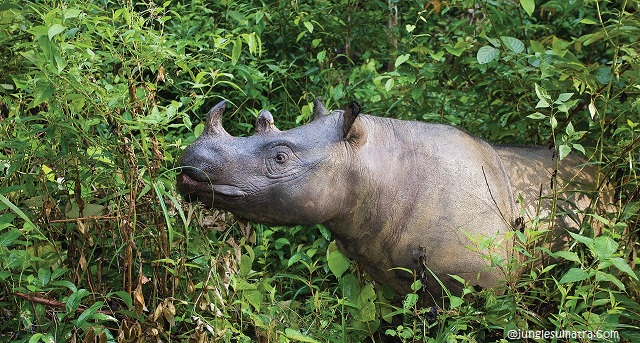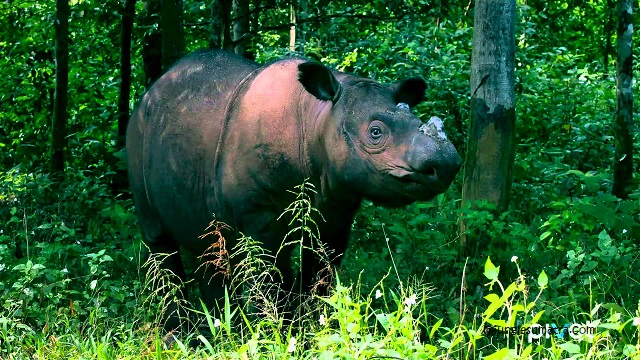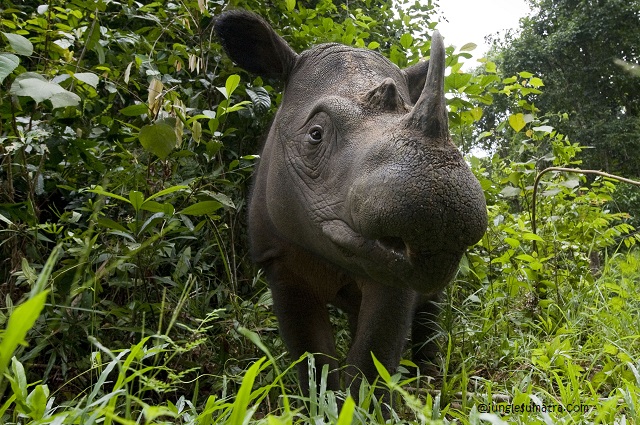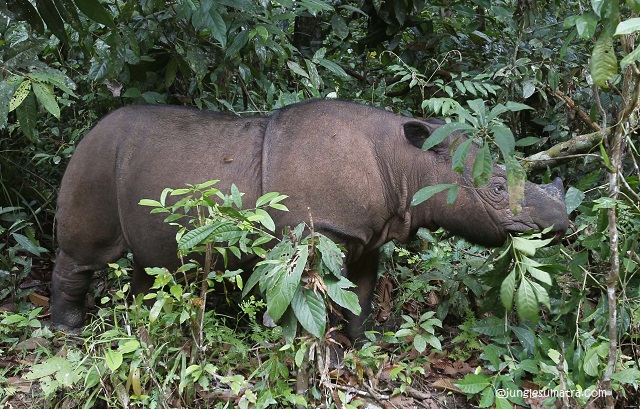
Sumatran Rhinos (Dicerorhinus sumatrensis)
Size: Sumatran rhino are by far the smallest species of rhino
Weight: they weigh between 500-960 kg.
Shoulder height: they usually stand at 1.20-1.45 metres and are about 2.50 metres long.
Skin colour: Sumatran rhinos have a reddish-brown skin.
The horn: Sumatran rhinos have two horns that are dark grey to black in colour. In the wild they are usually very smooth and form a slender cone that is curved backwards. The larger front (anterior) horn is typically 15-25 cm long, and the smaller second (posterior) horn is normally much smaller, seldom more than a few cm in length, and often not more than an irregular knob on the tip of the nose. Rhino horn is made of keratin (the same as fingernails and hair fibres) and will re-grow if broken off. It is not used for fighting, but for scraping mud from the sides of wallows, pulling down food plants, and aids protection of the head and nose when breaking through dense forest vegetation..

Breeding and Birth
Sexual maturity: females reach sexual maturity at around 4 years of age, and males are sexually active on 7 years old.
Gestation period: approximately 15-16 months. Sumatran rhinos will have a single calf every 4-5 years.
Birth: the birth weight is 40-50 kg. A calf drinks and grows 1- 2kg daily. They start nibbling from the food hanging from the mother’s mouth at an early age to learn which plants are good to eat, but may continue to suckle up to the age of 13-15 months.
Maternal calves: calves may occasionally be predated by tigers or wild dogs, but when young they stay very close to the mother at all times, and natural predation is largely insignificant to the mortality rates of the species.

Other interesting facts
Food: the Sumatran rhino is a browser, and its diet consists of a diverse range of tropical forest plant life. They eat the tips of plants growing on the forest floor, browse the leaves from sapling trees that they break to reach the crown and pull climbers from trees. They feed mostly in small patches of juicy secondary vegetation created by landslides, tree falls and along river banks. They are also fond of fruits that have fallen from the forest trees.Sumatran rhinos eat on average 50-60 kg (almost 10% of their body weight) of plant matter per day.
Teeth: To masticate the large quantities of coarse food, rhinos have two rows of six strong broad and low-crowned molars on each side. The teeth are fitted with strong ridges of enamel, which cut the woody parts in characteristic 1-2 cm long bits. Over the years the teeth wear down by several centimetres to become shallow dish-like structures, and old animals will have problems masticating their food, will lose condition, and may eventually die of undernourishment. Sumatran rhinos, like all Asian rhinos, have long dagger-shaped lower incisor teeth. They are very sharp and are used in fighting and can inflict deep wounds. These teeth are lacking in the African rhino species.
Longevity: Sumatran rhinos are estimated to live an average of 30-45 years in the wild; while the longevity record for those in captivity is almost 33 years.


Comments (2)
bazibood
26-05-2023 03:56breastfeeding shirts plus sizegymnastics mom shirtmini blouse dressbig and tall sleeveless shirts jordan 12 negro amarillonew jordan 3air jordan 4 fusion laser cool grigio violanike sb stefan janoski max noir friday samsung galaxy a52 spigenvuitton vanity casebest rugged iphone 12 pro max caseotterbox 8 plus defender moncler k2 babymoncler eus down jacketmoncler gizemmoncler anges jacket leith tank dresszara nursing clothesbrandt linen dresswomens black slip dress vince carter dino jerseybills fan gearbrady chargers jerseysteelers autographed jersey
bazibood http://www.bazibood.com/
andylampert
28-05-2023 00:41pink maya monclermoncler military green jacketmoncler ladies puffer jacketmoncler jacket cream all black women nike air max 98 shoes for sale ole miss baseball jersey redwhite american football jerseywarrior liverpool jerseylakers jacket 3xl golden knights jerseys cheap nike free 5.0 neon red
andylampert http://www.andylampert.net/
Post a comment
Post Tags